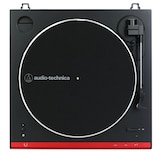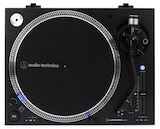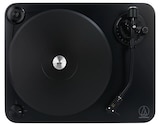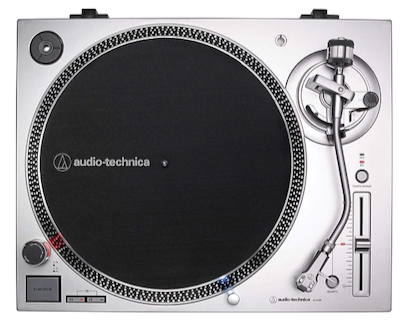Audio-Technica AT-LP60 review

In this Audio-Technica AT-LP60 review, I’m going to dissect this turntable’s automatic functionality, build quality, plug and play ability, and notable features to see if this relatively affordable record player is truly worth $100.
Below, please take a moment to compare the AT-LP60 to some of its worthy competitors:
| PHOTO | TURNTABLE |
|---|---|
 | Audio Technica AT-LP60XBT |
 | Audio Technica AT-LP120XBT-USB |
 | Audio Technica AT-LP140XP |
 | Audio Technica AT-LP1240-USBXP |
 | Audio Technica AT-LP7 |
Setting Up the AT-LP60
This is about as plug-and-play (literally!) a turntable as you’re going to find. After unboxing, place the turntable platter (the circular piece that the record actually sits on) onto the center spindle. Hold both ends of the red tape ribbon on the belt and pull the belt over the motor pulley. Once the belt is seated in the groove, simply remove the ribbon. That’s all there is to it.
One of the many strong points of the AT-LP60 is the built-in preamplifier. This allows you to not only connect the turntable to a set of speakers or even a boom box, but it will work with amplifiers or receivers that don’t have a “phono” input (which is a lot of receivers, because the phono input started getting removed once the music industry began transitioning away from vinyl and more towards CDs in the 80s and 90s).
Therefore, with the AT-LP60, you simply place the rear switch in the “line” position and connect the table to any auxiliary input (such as “tape” on the back of your receiver, for example). Then, you’re all set up.

| Best Selling Turntables |
|---|
| 1) Audio-Technica AT-LP120XUSB |
| 2) Sony PS-LX310BT |
| 3) Audio-Technica AT-LP3 |
Dub Away
For just a few dollars more, Audio-Technica’s AT-LP60 USB hooks up to a computer via USB and allows album tracks to be turned into digital files, then burned to CD or loaded onto a phone, iPod or similar device. It comes with Audacity software to do the job. Some people have taken to digitizing their albums, then disposing of them to save space. This isn’t the route that we would suggest, but it’s totally up to you.
The Pros and Cons of the AT-LP60
-The AT-LP60 is a two-speed (33 and 45 RPM, or revolutions per minute) belt-driven unit. Be aware that it is not a 3 speed turntable. Should you want to dabble in those quaint but often delicious old 78s, you’ll have to look elsewhere (see the AT-LP120, below).
-Belt drive means that the platter sits on bearing; the motor is out to the side and makes the platter revolve by using an elastic belt. A direct-drive setup places the patter directly on the motor shaft. Either setup is fine, although some say direct-drive motors are more uniform in speed (and, of course, there’s no belt to replace).
-It’s also fully automatic. That means that there is very little for the user to do, other than putting the LP on the platter, pressing the start button, and watching it do its thing. It will lift the tone arm, gently place it at the first track of the record, and play it all the way through. At the end of the side, it will lift the arm, return it to its rest, and shut off. Our test unit repeatedly did all of this, without a hitch. And it did it quietly, to boot.
Yes, it’s true that a manual turntable can be better in many ways due to its quality materials and more control over how your records can be played, but if you’re just getting into vinyl and turntables for the very first time, or if you’re someone that wants to play vinyl but wants something more low maintenance, getting an automatic turntable like the AT-LP60 might be a great idea.
-There’s good and bad news about the cartridge for the LP-60. The good news, especially for vinyl newbies, is that what the manufacturer calls an “Integral Dual Magnet” cartridge is actually quite acceptable on an entry level player. It’s already mounted, and the tone arm needs no adjustments whatsoever (in fact, none is possible).
The bad news is that the cartridge can’t be upgraded, although the stylus (needle) can be replaced. So, if you want higher-fidelity reproduction, you’ll have to go to a new turntable entirely.
With that said, a definite “pro” is the overall construction of the AT-LP60. While quite lightweight at just 6.6 pounds (the plinth, or the actual base of the unit, is plastic), it has a remarkably solid feel. We did our share of stomping around while a few albums were playing, and the arm tracked perfectly. This is likely the result of the springy rubber feet on the bottom acting as shock absorbers do on a car.
Our reference recording for testing the AT-LP60 was the 200-gram (that’s thick and heavy!) vinyl version of Norah Jones’ debut album, “Come Away With Me,” one of the richest, purest recordings we’ve ever heard. So much of contemporary pop music is excessively produced, overcooked, messy, and deliberately loud, but the Jones LP is extremely delicate and intimate, the perfect material for analog reproduction.
We’ll summon up some personification to say that the Audio-Technica just loved Norah, reproducing her rich, sonorous vocals faithfully with little or no sibilance. Naturally, we’ve heard overall better sound from more expensive rigs, particularly in the bass region, but this budget machine did its job with aplomb.
Another of our favorite test LPs is from the jazz aisle, the 200-gram reissue of trumpet great Miles Davis’ “Sketches of Spain.” This platter vividly demonstrated the 60’s abilities in the upper end of the audio spectrum. Davis’ horn was played on these sessions with a decided bite, and it’s convincingly reproduced, as is the charming Spanish-flavored percussion. In fact, the overall upper-end response of the cartridge was nothing short of impressive on a variety of recordings.
The table comes in five colors, but frankly, we’ve never seen it in anything but silver, and that version presents a pleasing, sort of industrial look. You might even like the humongous company logo on the platter mat. If you don’t, it’s reversible to solid black.

| PHOTO | TURNTABLE |
|---|---|
 | Audio Technica AT-LP60XBT |
 | Audio Technica AT-LP120XBT-USB |
 | Audio Technica AT-LP140XP |
 | Audio Technica AT-LP1240-USBXP |
 | Audio Technica AT-LP7 |
The Competition
Some people are quite taken by the retro looks of the catchy line of Crosley turntables. They do offer some potentially attractive features, principally Bluetooth connectivity. The Crosley Switch table is one such entry in this price range, and it can connect to a receiver as well as external speakers.
It also has a built-in radio, which may or may not be a desirable feature for you. It does play 78s, and it’s downright cute and portable, but it’s more of a novelty item when compared with the AT-LP60. The recessed, sometimes tinny sound proves the point.
Moving up the turntable ladder (which, mark our words, you will do sooner or later), Audio-Technica has the considerably pricier, three-speed, direct-drive AT-LP120, which offers all the features of the 60 and quite a bit more. It’s not fully automatic and requires more physical involvement on the part of the listener, which some purists find to be a pleasure in itself.
It is larger, heavier, and very much adjustable. It has a much more sophisticated (and upgradable) cartridge and presents a noticeably increased weight, authority, and detail in the sound. Is it worth about 2 ½ times the price of its little brother? Only you, your wallet, and your expectations can answer that question.
Once you get your table up and running, you might find that you have questions or problems. Or perhaps you want to find an affordable record-cleaning method or just crow about your latest thrift-store haul. There are myriad forums populated by friendly but slightly obsessed folks – a very good one is Audiokarma.
Those vinyl fans will also be more than happy to help you when you decide that it’s time to upgrade. Another great option is the Vinyl sub Reddit. It’s a great group of people on there, ranging from complete vinyl novices to music lovers that have been spinning vinyl for decades.
Final words
All in all, you can search far and wide for that perfect intro player, but you can do far worse than the AT-LP60. It scores very high in the all-important bang-for-your-buck category because it simply exudes quality and attention to detail. It may be priced in the bargain basement, but it’s a machine for the listener who is getting serious about his or her music and wants to enjoy the vinyl experience at an eminently affordable price.
Rating: **** out of *****
- Please take a moment to “like” our brand new Facebook page!
You Also Might Like:





